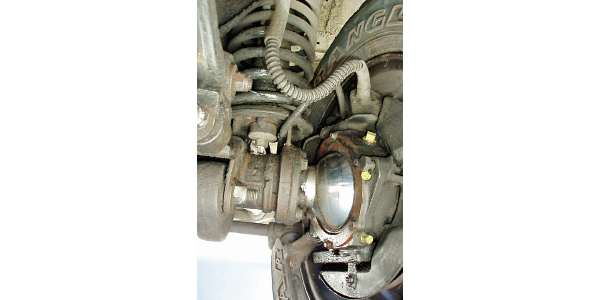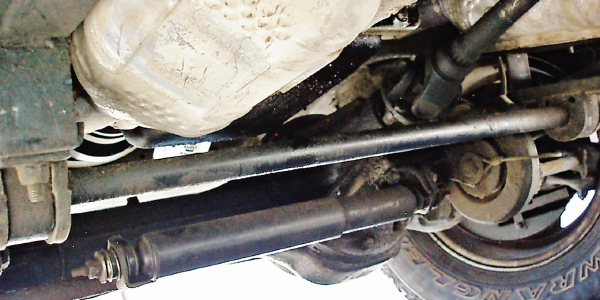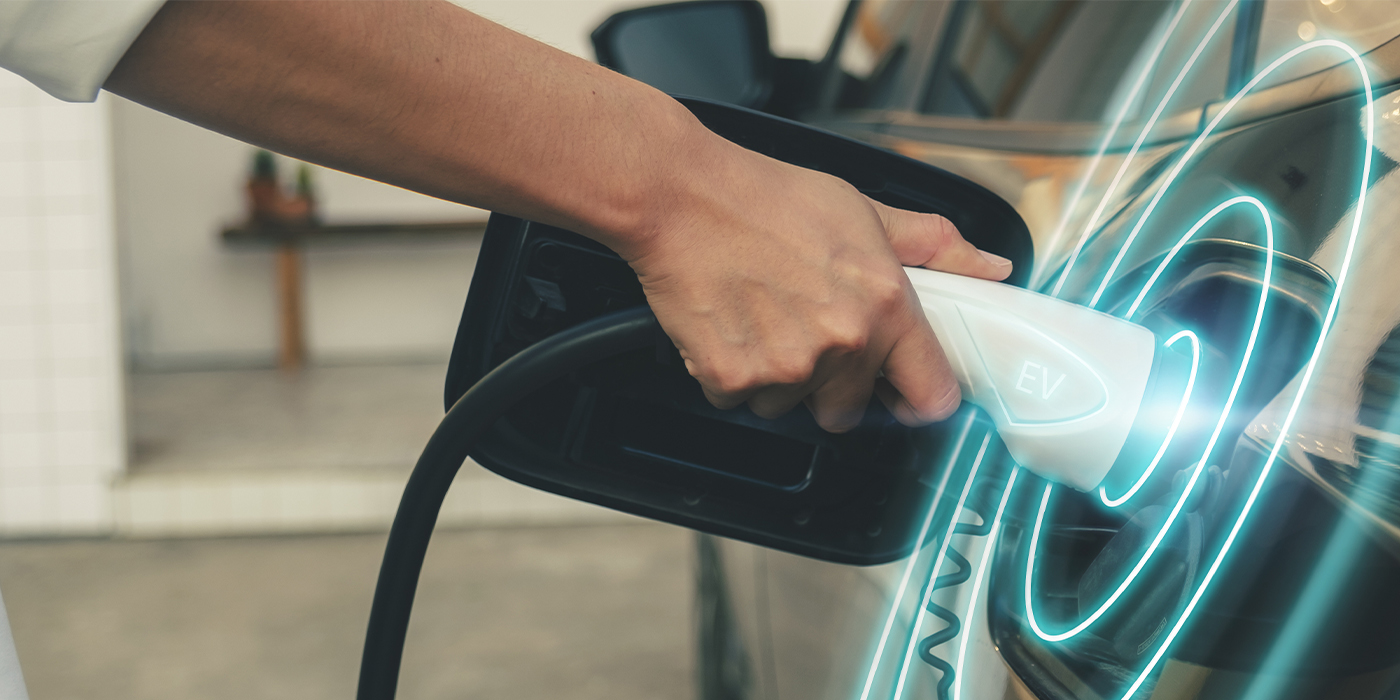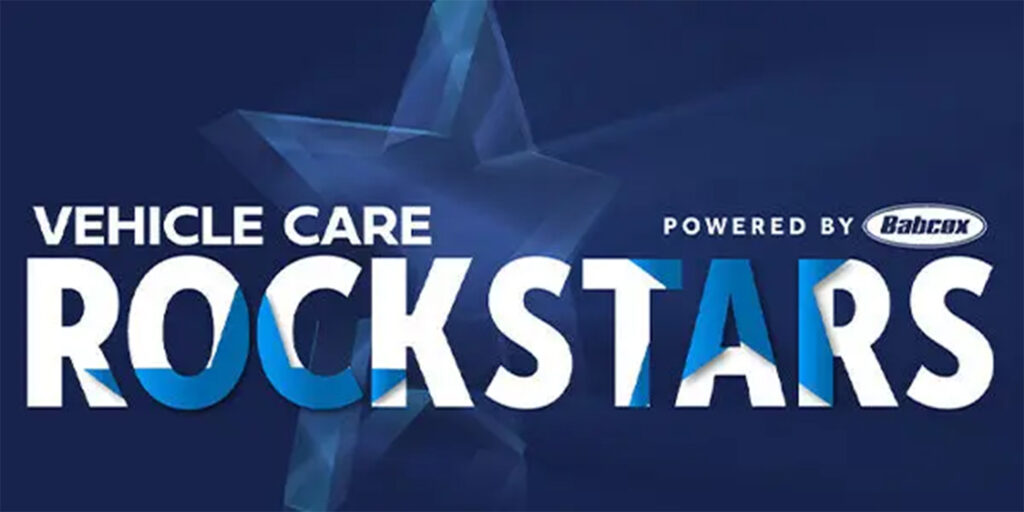
Four-wheeling has not only become a major participatory motor sport, it has become especially “cool” to be seen driving a four-wheel drive vehicle with over-sized tires, lift kit and custom bumpers. In my area, modifying older European and Asian SUVs and pickup trucks for navigating steep mountain trails has become especially popular. But so much for the glory, let’s look at what to do when these formidable four-wheelers begin to wobble, wander and weave on our public highways.
AWD vs. 4WD: In contrast to an all-wheel drive (AWD) vehicle, a four-wheel drive vehicle is typically equipped with a two-speed transfer case capable of driving in two or four-wheel drive and a Hotchkiss or “solid” rear drive axle for main propulsion. A four-wheel drive might incorporate either a solid front axle as with older Toyotas and Nissans or an independent front suspension as found in more modern configurations. With these configurations in mind, I’ll give you my take on how to deal with common steering complaints related to Hotchkiss drive vehicles most often used in four-wheel, high-country and desert-area off-roading.
WHEELS AND TIRES
It’s a given that tires on any four-wheel drive should be perfectly balanced with matching casing sizes, tread designs and rolling circumferences. It’s also a given that, when traveling over rock-strewn trails, larger diameter tires are required to increase axle-to-ground clearance. Larger diameter tires might also require positive-offset wheel rims to prevent the tires contacting the frame during extreme off-road maneuvers.
But offset wheels also contribute to alignment problems. In a perfectly engineered steering system, a line drawn through the upper and lower ball joints (steering axis inclination or SAI) should intersect with a vertical line drawn through the center of the tire tread at ground contact (See Photo 1). Perfect SAI allows the tire to pivot on its center as the steering wheel is turned, which reduces steering effort and the amount of road shock transmitted to the steering wheel during off-road driving.
When positive-offset wheels move the tire away from the chassis, the tire swings around its original pivot point much like a door swings on its hinges. This “door-hinge” effect dramatically alters steering geometry. Due to the door-hinge effect on steering linkage, added toe-in is required to maintain directional stability. Assuming that the wheel bearings, steering linkages, and suspension components are in like-new condition, most steering wander complaints will be aggravated by off-set wheel rims and extra-wide tread widths. Unfortunately, both are a necessary evil for extreme off-road driving.
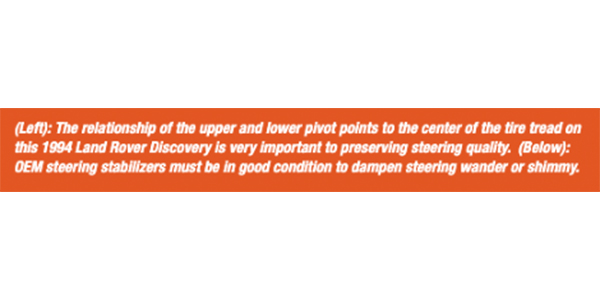
REAR AXLE ALIGNMENT
That said, I usually begin diagnosing steering wander complaints by looking at the condition of the rear drive axle and its mountings. If the rear axle thrust angle deviates from the chassis centerline under power, the steering gear is forced off its over-center position, which creates a wandering sensation in the steering wheel (see STEERING GEARS, page 24). Since a toed-out axle housing will contribute to rear axle wander, always examine rear-wheel alignment before beginning work on the front steering system.
While manufacturing tolerances are often very loose in older 4×4 vehicles. all four wheels should nevertheless form a rectangular box when the front tires are steered in the straight-ahead position. The center-to-center distance of the drive axles (wheel setback) on each side should measure roughly within an inch of each other and the closer, the better.
Most important, steering wander is often caused by worn leaf spring or trailing arm mounting bushings. In severe cases of bushing wear, a directional shift can often be felt in the steering wheel when the vehicle transitions from acceleration to deceleration. Since leaf spring center bolts locate the axle to the leaf spring, broken center bolts can also cause the rear drive axle to shift in relation to chassis centerline, which causes the vehicle to “dog-track.”
STEERING GEARS
Conventional steering gears suffer normal wear occurring between the horizontal steering shaft and vertical sector shaft gears, which contributes to steering wander. In brief, the steering shaft connects directly to the steering wheel. The sector shaft connects to the steering shaft through a recirculating, ball-bearing coupler running on a worm gear. The sector shaft connects to the steering linkage through the Pitman arm and drag link.
A minor over-center adjustment can be made by pointing the front wheels straight ahead, then loosening the lock nut on the sector shaft adjustment screw and gently turning the adjustment screw clockwise until it stops. While holding the adjusting screw lock nut in position, back the adjusting screw out half-turn and tighten the lock nut to specification.
To verify the over-center adjustment, lift the front wheels and steer the tires by hand through a full right and left-hand turn. The tightening effect of the over-center adjustment should be felt half-way through the steering system’s turning radius. At the half-way point, the tires should be in the straight-ahead position. If the steering gear binds, back the sector shaft adjustment screw off another half-turn. When turning right or left, some clearance or “lash” should be felt between the worm and sector shaft gears.
To provide the driver with a good sense of steering wheel position, the tires should be pointing straight ahead with the gear at over-center and the Pitman arm parallel to chassis centerline. If the steering gear is worn to the point it can’t be correctly adjusted, it’s simpler to replace the steering gear with a new or remanufactured unit. When 4WDs are equipped with rack-and-pinion steering gears, worn mounting grommets and loose mounting brackets are usually responsible for steering wander.
STEERING LINKAGE
To prevent steering wander, all pivot points in the steering linkage should be factory-tight. Since most tie rod ends are spring-loaded to compensate for wear, I use large water pump pliers to compress the tie rod end to sense how much wear is present.
Worn idler arms found in 4x4s equipped with independent front suspension can cause a severe change in toe angle when driving on crowned roads. I check idler arms by turning the passenger side wheel by hand and watching for any vertical movement in the idler arm assembly that might cause a toe angle change. As for ball joints, remember that, in most configurations, the pre-loaded upper joint maintains wheel alignment while the non-preloaded lower joint supports vehicle weight. I recommend replacing trunnion bearings or ball joints in sets of four to help eliminate steering wander.
TRACK BARS
When the front axle is suspended with coil springs, a track bar is required to maintain a solid connection between frame and drive axle. When the track bar pivot points wear, the front wheels will tend to wander or shimmy. Worn track bars are most responsible for “Death Wobble” or severe front-wheel shimmy on 4x4s equipped with solid front axles.
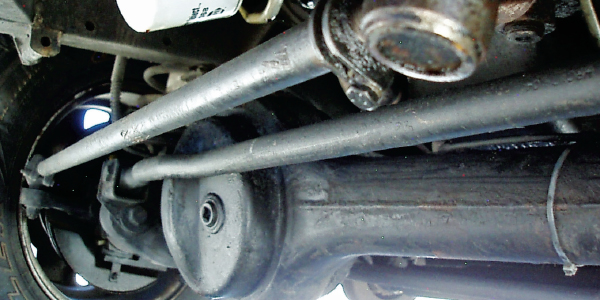
BUMP STEER
Raising ride height increases the operating angle of both the track bar and drag link on solid front axles. The greater the track bar and drag link angles, the greater the directional change when the front wheels strike a bump in the road, thus the term “bump steer.” Bump steer markedly affects independent front suspensions because the tie rods and control arms are operating at extreme angles, causing extreme variations in toe angle as the suspension is compressed or extended. Steering linkage geometry is the name of the game when diagnosing stock or modified suspension systems. If suspension travel creates major changes in toe angle, we have steering wander and shimmy, plain and simple.
The Origins of “Death Wobble”
- Steering shimmy or “Death Wobble” normally occurs on vehicles equipped with solid front drive axles at speeds above 40 mph.
- Death Wobble is initiated by irregularities in the road surface that cause rapid directional changes or oscillations in the front wheels.
- At this point, the two front wheels are fighting each other for directional control of the steering system.
- The driver can usually stop Death Wobble by rapidly applying the service brakes.
- Heavy-duty leaf springs will greatly reduce the tendency of the front wheels to rapidly oscillate or change direction.
- Heavy-duty steering dampeners also greatly reduce the tendency of the front wheels to rapidly oscillate or change direction
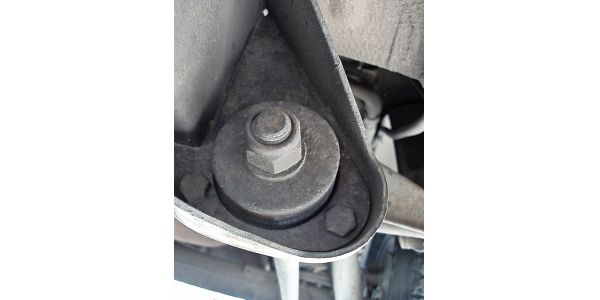
- Normal braking torque can cause front leaf springs to lose their positive caster angle, which aggravates steering wander and shimmy.
- Broken leaf spring center bolts, loose spring U-bolts and weak or broken spring leaves will aggravate steering wander and shimmy.
- In some cases, tapered shims can be used to increase positive caster angle on leaf spring suspensions.
- Reducing camber angle on applications with positive offset wheels moves the vehicle load closer to the tire tread center, which can reduce the tendency to wander or shimmy.
- Increasing toe and caster angles might, for example, reduce the wandering and shimmying effects caused by modified suspensions.
- Aligning the suspension system with the chassis centerline helps reduce steering wander and shimmy.

